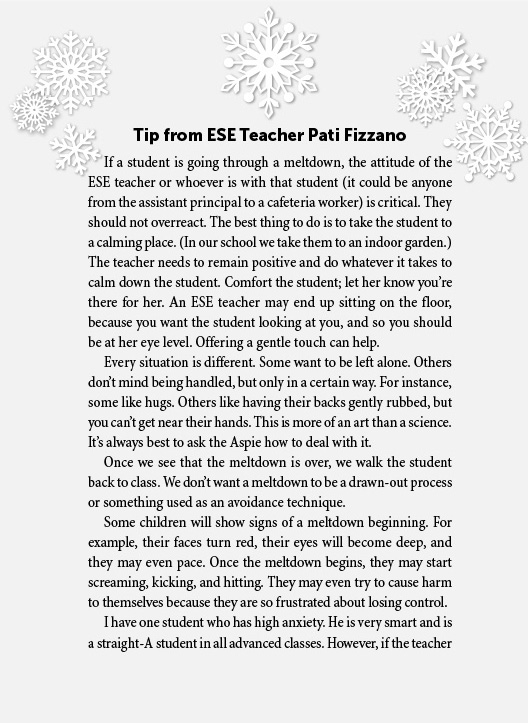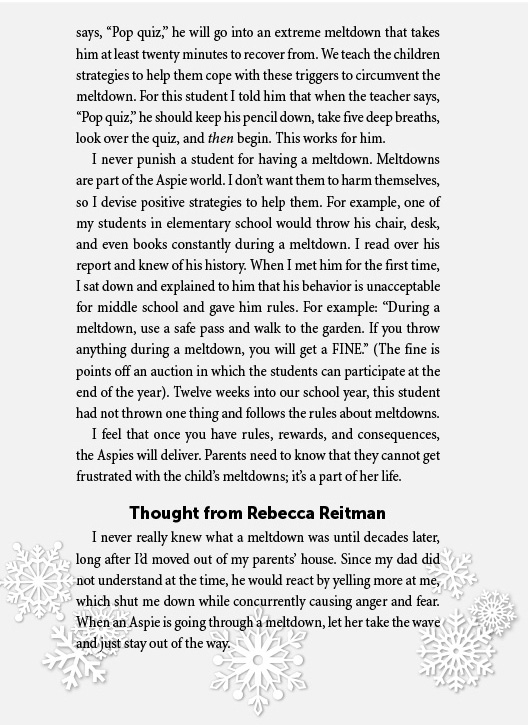
Sometimes it takes a
meltdown to cool down.
—Evinda Lepins, author of Back to Single
Helpful Hint: It’s critical to find ways to defuse an oncoming Aspie meltdown, because once it’s underway, there’s nothing the Aspie can do except ride it out. And there’s nothing you can do except provide quiet support in a safe place. By learning to recognize the triggers that lead up to the meltdown, you’ll often be able to ease the situation. Here is where an ounce of prevention is truly worth a ton of cure.
Principle: When marathon runners “hit the wall” and can’t go a single step farther, it’s not just due to physical factors like cramping and blisters. Psychological and neurological issues come into play as well. They just can’t do it. It’s the same with an Aspie meltdown. This force of nature—akin to a volcanic eruption—is a similar confluence of neurological, psychological, and physical factors.
For an Aspie, a meltdown and a temper tantrum are two entirely different things. The tantrum is about manipulation. For instance, a young Aspie may scream, “I want a puppy!” over and over. As a parent, you do your best to ignore it, but they won’t give up. They’ll demand a puppy until you give in (which you should not do) or until they get tired. You have to teach them that rather than throw a tantrum, they should use logic and rational persuasion to win you over to their point of view. (Yes, this can be taught with time and effort, and with rules, rewards, and consequences.)
But when Aspies have a meltdown, they’re not begging for anything. Rebecca said that what might start out as an issue that is unreasonable to the Aspie, is then acted upon and seen by others as a “tantrum,” and after this the meltdown starts. For example, one time Rebecca’s work schedule was changed without first consulting her. It was final; there was no going back, so she had to surrender to it. Rebecca saw this as deception because Pati had told her one thing but then changed it. Pati wanted to talk about what had already been established and that this was the way it had to be. Rebecca was furious, calling Pati a liar. She kept repeating that there was nothing to talk about and got increasingly anxious until she had a meltdown. Finally, she just left, knowing that it is better to remove yourself from the situation to a safe place. A meltdown is an Aspie crying out in anguish for someone to get her to a safe, quiet place, and either leave her alone or quietly comfort her. She’s overwhelmed in every way a human being can be overwhelmed.
An Asperger’s meltdown can be compared to an epileptic seizure. Simplistically speaking, in the case of epilepsy,13 the brain undergoes hyperactive electrical sensitivity, which can trigger a seizure. For someone with epilepsy, blinking or flashing lights can trigger a seizure. For those with Asperger’s syndrome, the equivalent of flashing lights can be someone invading their personal space or suddenly putting her hands on them, a strong scent, a loud noise, a funny taste, or merely something unexpected. Aspies will tell you that a meltdown can be the result of one of these triggers or an accumulation of them. (Plus, many Aspies have other neurological and psychological components that overlap.)
13 I believe there’s a higher incidence of epilepsy in autism and Asperger’s syndrome individuals than in the general population, and the same goes for other psychological and neurological syndromes. There’s overlap between these neurological and psychological syndromes. That’s why psychiatrists have to pass the neurology boards and neurologists have to pass the psychiatry boards.
Every Aspie has a different description of what a meltdown feels like. One says that when the pressure builds inside her, it’s like the cartoon character with steam coming out its ears before its head explodes, but Aspies all agree on one thing: once a meltdown begins, there’s nothing they can do until it runs its course.
Consequently, meltdowns, like seizures, should be avoided at all costs. Meltdowns can have dire consequences for an Aspie, such as being physically harmed, getting arrested, being incarcerated—or something far worse.
If you don’t recognize the situation in time to defuse it, this can feel like a parent’s worst nightmare. You may be tempted to ask God, “Why are you doing this to me?” and scream at the Aspie, “Knock it off! Get used to the real world!” This is about the worst thing you can do. You must be able to recognize the telltale signs of when the Aspie is experiencing stimuli or events that, left unchecked, will lead to a meltdown. Don’t be afraid to make a mountain out of a molehill. If you use observation to see these signs, and take preventive action, the molehill won’t become a mountain.
ACTION PLAN: Use observation to identify all the triggers that can set off your Aspie. If you want to keep track of them and maybe share them with other caring third parties, write them down in a journal. A journal can help you put the pieces of the puzzle together. Once you learn all the signs of mounting anxiety, you should be able to defuse the situation. If the situation is beyond defusing, your only option is to hustle the Aspie off to her safe place (which we’ll learn more about in the next chapter).
As your Aspie gets older, she will have to learn to manage defusing the meltdown without you through self-soothing or personal prevention methods. The goal is to become independent as much as possible. If she feels her anxiety rising and a meltdown approaching, she will know what to do next. She will find her safe place, take an action that begins to reduce her anxiety (such as pacing back and forth), think of what made her anxiety levels rise, and then engage in an interest (such as drawing) to help her forget about her anxiety.
Professionals, such as psychologists, and others specifically trained in this area—for example, yoga instructors—can teach Aspies methods for defusing the meltdown themselves. Not everyone can afford a psychologist or a coach, but every Aspie should have someone they can talk to.


